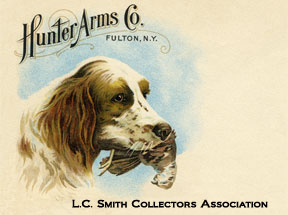|
The Hunter Arms Company maintained detailed order and production records, but all that remains are the shipping department ledgers which were recovered from a trash barrel by William Brophy; everything else was lost or destroyed by the Marlin Firearms Company. These serial numbers for pre-1913 shotguns were lost: 22,501 to 27,765, 46,000 to 49,999, 70,000 to 78,999, and 90,000 to 99,999.
Information on shotguns produced 1890 to 1917 is usually limited. Generally, the shipping records include only the shipping date, manufacturing date, barrel length, gauge, and grade. This information can, however, establish that your shotgun has not been upgraded and that the barrel length has not been modified. Both facts may be important in establishing the value of your shotgun.
Book 2 (around 1900) is a marked exception and often includes weight, stock dimensions, and where the gun was shipped. Most of the 1890 to 1917 books also have a letter symbol for the inspector ("P" was M.W. Mack). The symbol and the name of the inspector are included in research letters.
In most cases, more information is available for shotguns made between 1918 and 1950. In addition to the information for the early guns, the books may include dates of starting, proofing, patterning, finishing, and shipping. The name of the company to which it was shipped and the order number are usually in the records. Occasionally, the name of the person ordering the shotgun will be noted, but many shotguns were ordered through a local or regional sporting goods or hardware company. In those cases, the name of the final purchaser was not recorded in the ledger. The shipping records usually contain a list of the options (such as REOBV which stands for regular weight frame, automatic ejectors, selective Hunter One-Trigger, beavertail forend, and ventilated rib) and occasionally contain special order information (such as a initials engraved on the trigger guard.)
The Marlin era guns (primarily the L.C. Smith Gun Company 1945 to the end of production) usually contain all of the information provided in the 1918-1945 shipping records. The proof and patterning dates may be missing however. Late in production, many of the records do not include who ordered the shotgun. The records include the 1968 to 1971 Field Grade shotguns, but the information for the Deluxe Models is missing.
The LCSCA now has excellent database for DeLuxe, Premier, Monogram, Crown, Eagle, Specialty, Trap, Olympic Premier Skeet, Skeet Special, Pigeon, No. 4, No.5, .410s (including the Fulton and Hunter Special shotguns), Long Range/Wild Fowl, and Single Barrel Trap (SBT) shotguns. We have found that the numbers of shotguns in many of the grades vary considerably from information published by Brophy and Houchins. With the database, we are able to tell you how many were made with each of the various options and how many had the exact configuration of your L.C. Smith. Research is continuing on other grades and variants.
Your letter will be printed on reproduction circa 1900 Hunter Arms Company letterhead; 100% rag, 32 pound, and acid free paper. Each letter is assigned a research number that is embossed with the LCSCA seal over gold foil. The letter is placed in an archival plastic sleeve and mailed flat.
Research Letters
COPYRIGHT
L.C. Smith Collectors
Association 2015
Updated 02/17/2015
|

